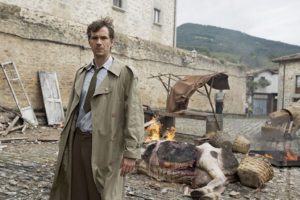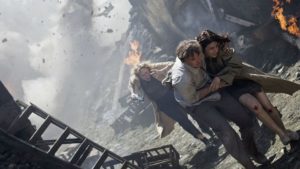Coluna Claquete – August 29, 2016 – Movie of the Week: “Gernika”
Newton Ramalho
colunaclaquete@gmail.com – www.colunaclaquete.blogspot.com – @colunaclaquete
Movie of the Week: “Gernika”
The history of humanity is full of conflicts, so many that most people are aware only of the most important ones. But one of these conflicts, the Spanish Civil War, was marked by a brutal and cowardly event that was immortalized by Pablo Picasso in a special painting. The table, the city and the film inspired by this tragic story has the same name: “Gernika” (2016).
In order to help the reader, I will make a very brief contextualization. After the end of the monarchy in the early 1930s, it was installed the republican system in Spain. Over the decade, the clashes between the left and right culminated in a military coup led by General Franco, unleashing a bloody war that would drag on until 1939.
The nationalists, led by general Francisco Franco, had the support of Hitler and Mussolini, while Republicans were supported by the Soviet Union and international volunteers. The world situation was very tense, because everyone knew that soon would happen a new world war.
The world at that time was very different from today. Germany and Italy, under the rule of Hitler and Mussolini, had risen from the rubble of World War I, and were new military powers increasingly aggressive.
England still had many colonies, including India and Pakistan, having the nickname “the empire where the sun never sets.” Africa, with few exceptions, was formed by European colonies.
In much of the world, including Brazil, governments were right-wing dictatorships. Japan had emerged from a millennial isolation to a bellicose expansionism, and at that time had already invaded Manchuria and much of China.
At this tension level, it was natural that the United States, Britain and France avoided getting involved in the Spanish conflict, as they were aware that a much larger war was very near.
It is at this point that we find in Bilbao, in northern Spain, a group of journalists trying to cover the war. Among them is the American Henry Howell (James D’Arcy), a veteran war correspondent. Cynical and disillusioned, Howell chafes at censorship of the communication department of the Republicans, which prohibited any news that appeared being negative.
The censors were Spanish Teresa (Maria Valverde) and Russian Vasyl (Jack Davenport), the latter serving instructions received directly from Moscow.
Howell is bounded to confront their own demons when understands that he must let the world knows what is really happening there.The time to break is the cowardly bombing of the small town of Guernica, made by German and Italian aircraft, successfully testing a new tactic of war, the blitzkrieg.
It’s odd the way Hollywood appropriates historical facts to retell them with its own version. Howell’s character is inspired by George Steer, a British journalist born in South Africa. Although he was not in town at the time of the bombing, he arrived there shortly after and was able to build the story based on what he saw and the reporting of survivors. The telegram sent to his newspaper, the Times of London, is considered a milestone in the history of journalism. Oddly, he would lose his job because the editor sympathized with General Franco.
Although the film has made a good reconstitution time, some poetic liberties were dissonant, like the use of intercontinental phone call with great ease.I remember that in the 1960s, getting a link to another state was already a complication, imagine in the 30s and in the midst of a war…
The famous Spanish painter Pablo Picasso was inspired by the tragic story of the bombing in Guernica to create what would be his most famous painting. However, he imposed one condition: the picture could only come to Spain when democracy was restored. This desire took too long to be realized, as General Franco still ruled Spain with an iron fist until his death in 1975.
For those interested in this subject, I recommend, in addition to “Gernika”, the movies “Land and Freedom”, “Libertarias” and “Hemingway & Gellhorn”.And in books, “Homage to Catalonia” by George Orwell, “For Whom the Bell Tolls?”, by Ernest Hemingway, and “Saga”, from Brazilian writer Érico Veríssimo.










